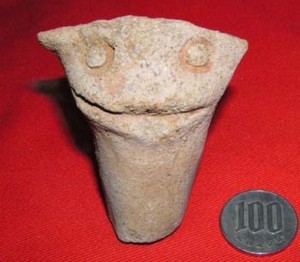 Archaeologists in the town of Umi in Fukuoka prefecture have excavated a piece of earthenware shaped as the head of a creature with googly eyes and a big grin. Opinions are divided about whether this artifact, which was unearthed from a site dating back to the Muromachi period (1336 to 1573 AD), is supposed to represent the head of a demon, dragon, snake or kappa.
Archaeologists in the town of Umi in Fukuoka prefecture have excavated a piece of earthenware shaped as the head of a creature with googly eyes and a big grin. Opinions are divided about whether this artifact, which was unearthed from a site dating back to the Muromachi period (1336 to 1573 AD), is supposed to represent the head of a demon, dragon, snake or kappa.
Kappa are mythical (or real, according to some) creatures that live in Japanese rivers and ponds. Known as pranksters, kappa are notorious for luring people (particularly small children) into water and drowning them. They also like to eat cucumbers. Some theories suggest that the word kappa comes from the Portuguese capa, which refers to the "robe" worn by Portuguese monks who came to Japan in the 16th century. The kappa's hairstyle also resembles the tonsured hair of the monks. (Further reading: Wikipedia entry for kappa.)
The artifact, which is now on display at Umi Museum, measures 5.4 cm (2 in.) tall and is believed to be one of the feet of a larger earthenware vessel. It appears that a sharp bamboo implement was used to shape the eyes and mouth.
"If this is a kappa," says museum director Koji Hiranouchi, "it is a very old representation. The craftsman was probably playing around when he made it."
Others believe the artifact is supposed to represent some sort of reptile or amphibian.
[Source: Iza!]
==========
If you ever decide to keep a kappa as a pet, check out the indispensable Kappa no Kaikata (How to Raise a Kappa), a 26-part series of animated shorts on Animax, with English subtitles (viewable on YouTube). These videos will help you avoid some of the pitfalls of raising a kappa. For example, the first episode shows the disastrous effects of what happens when you feed kappa-maki (cucumber sushi rolls) to your kappa. Evidently, wasabi disagrees with its digestive system.

 On June 21, researchers at Waseda University's Institute of Egyptology unveiled the computer-generated facial image of an ancient Egyptian military commander that lived about 3,800 years ago. The image is based on CAT scans taken of a mummy.
On June 21, researchers at Waseda University's Institute of Egyptology unveiled the computer-generated facial image of an ancient Egyptian military commander that lived about 3,800 years ago. The image is based on CAT scans taken of a mummy. A consortium of Kyushu-area businesses, including robot developer TMSUK (Kitakyushu), has developed a compact robot hand. In Fukuoka on January 9, a robot equipped with the hands demonstrated its dexterity by scooping candy into bags.
A consortium of Kyushu-area businesses, including robot developer TMSUK (Kitakyushu), has developed a compact robot hand. In Fukuoka on January 9, a robot equipped with the hands demonstrated its dexterity by scooping candy into bags.